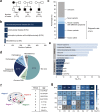Genomic profiling of 553 uncharacterized neurodevelopment patients reveals a high proportion of recessive pathogenic variant carriers in an outbred population
- PMID: 31996704
- PMCID: PMC6989631
- DOI: 10.1038/s41598-020-58101-8
Genomic profiling of 553 uncharacterized neurodevelopment patients reveals a high proportion of recessive pathogenic variant carriers in an outbred population
Abstract
A substantial portion of Mendelian disease patients suffers from genetic variants that are inherited in a recessive manner. A precise understanding of pathogenic recessive variants in a population would assist in pre-screening births of such patients. However, a systematic understanding of the contribution of recessive variants to Mendelian diseases is still lacking. Therefore, genetic diagnosis and variant discovery of 553 undiagnosed Korean patients with complex neurodevelopmental problems (KND for Korean NeuroDevelopmental cohort) were performed using whole exome sequencing of patients and their parents. Disease-causing variants, including newly discovered variants, were identified in 57.5% of the probands of the KND cohort. Among the patients with the previous reported pathogenic variants, 35.1% inherited these variants in a recessive manner. Genes that cause recessive disorders in our cohort tend to be less constrained by loss-of-function variants and were enriched in lipid metabolism and mitochondrial functions. This observation was applied to an estimation that approximately 1 in 17 healthy Korean individuals carry at least one of these pathogenic variants that develop severe neurodevelopmental problems in a recessive manner. Furthermore, the feasibility of these genes for carrier screening was evaluated. Our results will serve as a foundation for recessive variant screening to reduce occurrences of rare Mendelian disease patients. Additionally, our results highlight the utility and necessity of whole exome sequencing-based diagnostics for improving patient care in a country with a centralized medical system.
Conflict of interest statement
The authors declare no competing interests.
Figures



References
MeSH terms
Grants and funding
LinkOut - more resources
Full Text Sources

